Green Tunnel Solutions: An Overview of Sustainability Trends in the Last Decade (2013–2022)
Abstract
1. Introduction
2. Materials and Methods
- Identification of research materials (topic, database and keywords);
- Initial filtering of content (according to the purposes of the abstract);
- Eligibility assessment of publications with respect to search criteria (in continuity with the research scope);
- Meta-analysis of selected papers (full-text review).
2.1. Identification: Data Collection Process
- Topic: green road tunnel solutions using renewables energies;
- Database and time frame: Scopus, from 2013 to 2022;
- Eligibility: an analysis of the selected papers’ abstracts to evaluate their inclusion/exclusion in the study;
- Classification and Categorisation: selected articles were analysed according to the eligibility criterion and classified into ‘subject topic’ areas in the results section.
2.2. Filtering (Search Strategy): Formulation and Database
- Query A: ‘energy’ ‘saving’ ‘road’ ‘tunnel’;
- Query B: ‘sustainable’ ‘infrastructure’ ‘tunnel’;
- Query C: ‘energy’ ‘lighting’ ‘zero’ ‘tunnel’.
2.3. Eligibility: Metrics Results
2.4. Meta-Analysis Statement: Full-Text Review
3. Bibliometrics
4. Results of Meta-Analysis
4.1. Sustainable Infrastructure
4.2. Renewable Sources
4.3. Zero-Energy Tunnel
4.4. Tunnel Safety Lighting
5. Discussion
- Most articles presented in the results section are conceptual, and the proposed solutions and methodologies are carried out via simulations or analytical models. Although some experimental research has been presented (see Figure 7), this disparity highlights the need to conduct more real-scale tests to verify the feasibility of sustainability solutions;
- Major trends in the last decade have resulted in the energy optimisation of road luminaires with attention to the problem of light reflectance and the energy needed for the portal gates of the tunnel;
- Reviews report key points of sustainability perspectives [17] for presenting state-of-the-art solutions;
- The 46 articles presented herein show the complex relationship between different elements of a tunnel system: tunnel lighting, energy consumption and safety. This demonstrates how engineering can be considered as a whole when different subjects are connected through the principles of sustainability;
- From the results, a clear direction appears. Most studies apply experimental research and theoretical frameworks to the issue of tunnel lighting. This is due to strict regulations that impose mandatory parameters on tunnels. If we consider what the state-of-the-art is now, we can work to change the design priorities. For example, if we can demonstrate a way to secure the same amount of energy through the use of alternative sources, we could then design and enact systems from this starting point and not be obligated to adjust engineering design to accommodate regulations. By doing so, we can achieve a sustainable and resilient tunnel infrastructure.
6. Conclusions and Future Directions
Author Contributions
Funding
Institutional Review Board Statement
Informed Consent Statement
Conflicts of Interest
Appendix A
| No | Author | Year | Subject Topic Code |
| [58] | Yang, C., Fan, S.J. | 2013 | S.4 |
| [29] | Sauer, J., Fischer, O. | 2013 | S.1 |
| [60] | Peña-García, A., Gil-Martín, L.M. | 2013 | S.4 |
| [51] | Lai, W., Liu, X., Chen, W., Lei, X., Cheng, X. | 2014 | S.2 |
| [46] | Gil-Martín, L.M., Peña-García, A., Jiménez, A., Hernández-Montes, E. | 2014 | S.2 |
| [61] | Abdul Salam, A.O., Mezher, K.A. | 2014 | S.4 |
| [66] | Kimura, M., Hirakawa, S., Uchino, H., Motomura, H., Jinno, M. | 2014 | S.4 |
| [59] | Tsai, M.-S., Lee, X.-H., Lo, Y.-C., Sun, C.-C. | 2014 | S.4 |
| [39] | Salata, F., Golasi, I., Bovenzi, S., Vollaro, E.L., Pagliaro, F., Cellucci, L., Coppi, M., Gugliermetti, F., Vollaro, A.L. | 2015 | S.1 |
| [38] | Parise, G., Martirano, L., Parise, L. | 2015 | S.1 |
| [50] | Peña-García, A., López, J.C., Grindlay, A.L. | 2015 | S.2 |
| [37] | Parise, G., Martirano, L., Parise, L., Carrarini, L., Mitolo, M. | 2015 | S.1 |
| [62] | Schranil S.; Stachetzki J. | 2015 | S.4 |
| [28] | Tarada F. | 2015 | S.1 |
| [70] | Salata, F.; Golasi, I.; Bombelli, E.; De Lieto Vollaro, E.; Nardecchia, F.; Pagliaro, F.; Gugliermetti, F.; De Lieto Vollaro, A.L. | 2015 | S.4 |
| [33] | Moretti, L., Cantisani, G., Di Mascio, P. | 2016 | S.1 |
| [45] | Peña-García, A., Gil-Martín, L.M., Hernández-Montes, E. | 2016 | S.2 |
| [70] | Salata, F., Golasi, I., Poliziani, A., Futia, A., Vollaro, E.L., Coppi, M., Vollaro, A.L. | 2016 | S.4 |
| [31] | Makana L.O.; Jefferson I.; Hunt D.V.L.; Rogers C.D.F. | 2016 | S.1 |
| [54] | Guo, C., Xu, J., Yang, L., Guo, X., Zhang, Y., Wang, M. | 2017 | S.3 |
| [49] | Yang, C., Fan, S. | 2017 | S.2 |
| [43] | Galmarini, G., Dell’Agostino, S., Gobbi, M., Mastinu, G. | 2017 | S.2 |
| [42] | Peña-García, A. | 2017 | S.2 |
| [65] | Qin, L., Dong, L., Xu, W., Zhang, L., Yan, Q., Chen, X. | 2017 | S.4 |
| [47] | García-Trenas, T., López, J.C., Peña-García, A. | 2018 | S.2 |
| [53] | Yang, C., Li, M., Xiao, Y., Xu, Y. | 2018 | S.3 |
| [63] | López J.C.; Peña-García A. | 2018 | S.4 |
| [36] | Bracale, A., Caramia, P., Varilone, P., Verde, P. | 2019 | S.1 |
| [52] | Doulos, L.T., Sioutis, I., Tsangrassoulis, A., Canale, L., Faidas, K. | 2019 | S.3 |
| [30] | Farag S.G. | 2019 | S.1 |
| [67] | Krispel, S., Peyerl, M., Maier, G. | 2019 | S.4 |
| [56] | Sun, D., Athienitis, A., D’Avignon, K. | 2019 | S.3 |
| [41] | Petrov, S., Todorov, G., Pachamanov, A. | 2019 | S.2 |
| [55] | Liu, W., Chen, J., Luo, Y., Shi, Z., Wu, Y., Xu, Z., Dong, F. | 2020 | S.3 |
| [40] | Peña-García, A., Gómez-Lorente, D. | 2020 | S.2 |
| [69] | Fang, Y., Shen, J., Chen, J., Wang, J., Li, W. | 2020 | S.4 |
| [64] | Wang, Y., Cui, Y., Chen, F., Ren, R. | 2020 | S.4 |
| [17] | Gijzel D.; Bosch-Rekveldt M.; Schraven D.; Hertogh M. | 2020 | S.1 |
| [34] | Luo Y.; Alaghbandrad A.; Genger T.K.; Hammad A. | 2020 | S.1 |
| [44] | Zhao, J., Feng, Y., Yang, C. | 2021 | S.2 |
| [35] | Caldera S.; Mostafa S.; Desha C.; Mohamed S. | 2021 | S.1 |
| [48] | Peña-García, A. | 2022 | S.2 |
| [8] | Shen, Y., Deng, Y., Li, T., Zhou, L., Feng, S., Zhu, H. | 2022 | S.1 |
| [5] | Qi, D., Yang, S., Shu, C., Zhang, X., Wang, L.L., Athienitis, A. | 2022 | S.3 |
| [57] | Jiang, Z., Jia, C., Zheng, P., Gong, Y., Li, N., Ahmed, A., Zhang, Z., Luo, D. | 2022 | S.3 |
| [32] | Bergman F.; Anderberg S.; Krook J.; Svensson N. | 2022 | S.1 |
References
- United Nations Take Action for the Sustainable Development Goals. Available online: https://www.un.org/sustainabledevelopment/sustainable-development-goals/ (accessed on 20 September 2022).
- Kranz, J.; Schwichow, M.; Breitenmoser, P.; Niebert, K. The (Un)political Perspective on Climate Change in Education—A Systematic Review. Sustainability 2022, 14, 4194. [Google Scholar] [CrossRef]
- PIARC Technical Committee 3.3 Road Tunnel Operation. Road Tunnel Operations: First Steps towards a Sustainable Approach; (Technical Report 2017RO2EN); PIARC Technical Committee 3.3 Road Tunnel Operation: Paris, France, 2017. [Google Scholar]
- Adden, H.; Engelhardt, S.; Friebel, W.D.; Lehan, A.; Schwarz, J.; Speier, L.; Thewes, M.; Vogt, P. Recommendations for the Determination of Lifecycle Costs for Road Tunnels; German Tunnelling Committee (DAUB): Cologne, Germany, November 2018. [Google Scholar]
- Qi, D.; Yang, S.; Shu, C.; Zhang, X.; Wang, L.L.; Athienitis, A. An exploratory study on road tunnel with semi-transparent photovoltaic canopy—From energy saving and fire safety perspectives. Build. Simul. 2022, 15, 537–548. [Google Scholar] [CrossRef]
- Mehri, A.; Hajizadeh, R.; Dehghan, S.F.; Nassiri, P.; Jafari, S.M.; Taheri, F.; Zakerian, S.A. Safety Evaluation of the Lighting at the Entrance of a Very Long Road Tunnel: A Case Study in Ilam. Saf. Health Work. 2017, 8, 151–155. [Google Scholar] [CrossRef] [PubMed]
- Parise, G.; Lombardi, M. Ethics and Eco-Design for Complex Uses of Energy: What We Need for a Sustainable Future. IEEE Ind. Appl. Mag. 2022, 28, 74–79. [Google Scholar] [CrossRef]
- Shen, Y.; Deng, Y.; Li, T.; Zhou, L.; Feng, S.; Zhu, H. Determining multidimensional diffuse reflection effects in city tunnel lighting environment. Build. Environ. 2022, 212, 108796. [Google Scholar] [CrossRef]
- Shen, Y.; Ling, J.; Li, T.; Zhou, L.; Feng, S.; Zhu, H. Diffuse reflection-based lighting calculation model and particle swarm optimization algorithm for road tunnels. Tunn. Undergr. Space Technol. 2022, 124, 104457. [Google Scholar] [CrossRef]
- Huy Majer, M.; Woegerbauer, M.; Winkler, L.; Mazak-Huemer, A.; Biedermann, H. An Interdisciplinary Systematic Review on Sustainability in Tunneling—Bibliometrics, Challenges, and Solutions. Sustainability 2022, 14, 2275. [Google Scholar] [CrossRef]
- PRISMA. Prisma—Transparent Reporting of Systematic Reviews and Meta-Analyses. Available online: http://prisma-statement.org/ (accessed on 20 September 2022).
- Prisma Flow Diagram. Available online: https://www.prisma-statement.org//PRISMAStatement/FlowDiagram (accessed on 30 September 2022).
- Elsevier. Scopus—Document Search. Available online: https://www.scopus.com (accessed on 20 September 2022).
- United Nations. The Sustainable Development Agenda. Available online: https://www.un.org/sustainabledevelopment/development-agenda/ (accessed on 20 September 2022).
- Baas, J.; Schotten, M.; Plume, A.; Côté, G.; Karimi, R. Scopus as a curated, high-quality bibliometric data source for academic research in quantitative science studies. Quant. Sci. Stud. 2020, 1, 377–386. [Google Scholar] [CrossRef]
- Falagas, M.E.; Pitsouni, E.I.; Malietzis, G.A.; Pappas, G. Comparison of PubMed, Scopus, Web of Science, and Google Scholar: Strengths and weaknesses. FASEB J. 2007, 22, 338–342. [Google Scholar] [CrossRef]
- Gijzel, D.; Bosch-Rekveldt, M.; Schraven, D.; Hertogh, M. Integrating sustainability into major infrastructure projects: Four perspectives on sustainable tunnel development. Sustainability 2020, 12, 6. [Google Scholar] [CrossRef]
- Barry, J.; Proops, J. Seeking sustainability discourses with Q methodology. Ecol. Econ. 1999, 28, 337–345. [Google Scholar] [CrossRef]
- Scimago Compare Journal. Available online: https://www.scimagojr.com/comparejournals.php?ids[]=29593 (accessed on 30 September 2022).
- Scimago Journal Rank. Available online: https://www.scimagojr.com/journalrank.php?category=2603 (accessed on 30 September 2022).
- Donthu, N.; Kumar, S.; Mukherjee, D.; Pandey, N.; Lim, W.M. How to conduct a bibliometric analysis: An overview and guidelines. J. Bus. Res. 2021, 133, 285–296. [Google Scholar] [CrossRef]
- Broadus, R.N. Toward a definition of “bibliometrics”. Scientometrics 1987, 12, 373–379. [Google Scholar] [CrossRef]
- Glänzel, W.; Schubert, A. Analysing Scientific Networks Through Co-Authorship. In Handbook of Quantitative Science and Technology Research; Moed, H.F., Glänzel, W., Schmoch, U., Eds.; Springer: Dordrecht, The Netherland, 2004; pp. 257–276. [Google Scholar] [CrossRef]
- Zeng, L.; Li, R.Y.M.; Nuttapong, J.; Sun, J.; Mao, Y. Economic Development and Mountain Tourism Research from 2010 to 2020: Bibliometric Analysis and Science Mapping Approach. Sustainability 2022, 14, 562. [Google Scholar] [CrossRef]
- Van Eck, N.J.; Waltman, L. Visualizing bibliometric networks. In Measuring Scholarly Impact: Methods and Practice; Ding, Y., Rousseau, R., Wolfram, D., Eds.; Springer: Cham, Switzerland, 2014; pp. 285–320. [Google Scholar] [CrossRef]
- Scimago Viztools. Available online: https://www.scimagojr.com/viztools.php (accessed on 30 September 2022).
- Regufe, M.J.; Pereira, A.; Ferreira, A.F.P.; Ribeiro, A.M.; Rodrigues, A.E. Current Developments of Carbon Capture Storage and/or Utilization–Looking for Net-Zero Emissions Defined in the Paris Agreement. Energies 2021, 14, 2406. [Google Scholar] [CrossRef]
- Tarada, F. Is Tunnel Ventilation Sustainable? Available online: https://mosen.global/wpcontent/uploads/2011/01/Is-Tunnel-Ventilation-Sustainable.pdf (accessed on 20 September 2022).
- Sauer, J.; Fischer, O. Sustainability considerations for tunnel projects. In Research and Applications in Structural Engineering, Mechanics and Computation, Proceedings of the 5th International Conference on Structural Engineering, Mechanics and Computation (SEMC 2013), Cape Town, South Africa, 2–4 September 2013; CRC Press: Boca Raton, FL, USA, 2013; pp. 2463–2466. [Google Scholar]
- Farag, S.G. Application of Smart Structural System for Smart Sustainable Cities. In Proceedings of the 2019 4th MEC International Conference on Big Data and Smart City (ICBDSC), Muscat, Oman, 15–16 January 2019. [Google Scholar] [CrossRef]
- Makana, L.O.; Jefferson, I.; Hunt, D.V.L.; Rogers, C.D.F. Assessment of the future resilience of sustainable urban sub-surface environments. Tunn. Undergr. Space Technol. 2016, 55, 21–31. [Google Scholar] [CrossRef]
- Bergman, F.; Anderberg, S.; Krook, J.; Svensson, N. A Critical Review of the Sustainability of Multi-Utility Tunnels for Colocation of Subsurface Infrastructure. Front. Sustain. Cities 2022, 4, 847819. [Google Scholar] [CrossRef]
- Moretti, L.; Cantisani, G.; Di Mascio, P. Management of road tunnels: Construction, maintenance and lighting costs. Tunn. Undergr. Space Technol. 2016, 51, 84–89. [Google Scholar] [CrossRef]
- Luo, Y.; Alaghbandrad, A.; Genger, T.K.; Hammad, A. History and recent development of multi-purpose utility tunnels. Tunn. Undergr. Space Technol. 2020, 103, 103511. [Google Scholar] [CrossRef]
- Caldera, S.; Mostafa, S.; Desha, C.; Mohamed, S. Exploring the Role of Digital Infrastructure Asset Management Tools for Resilient Linear Infrastructure Outcomes in Cities and Towns: A Systematic Literature Review. Sustainability 2021, 13, 11965. [Google Scholar] [CrossRef]
- Bracale, A.; Caramia, P.; Varilone, P.; Verde, P. Probabilistic Estimation of the Energy Consumption and Performance of the Lighting Systems of Road Tunnels for Investment Decision Making. Energies 2019, 12, 1488. [Google Scholar] [CrossRef]
- Parise, G.; Martirano, L.; Parise, L.; Carrarini, L.; Mitolo, M. The Electrical Systems of Roadway Tunnels: Safety Design and Ecomanagement. IEEE Trans. Ind. Appl. 2014, 51, 1920–1927. [Google Scholar] [CrossRef]
- Parise, G.; Martirano, L.; Parise, L. The energetic impact of the lighting system in the road tunnels. In Proceedings of the 2015 IEEE/IAS 51st Industrial & Commercial Power Systems Technical Conference (I&CPS), Calgary, AB, Canada, 5–8 May 2015; pp. 1–7. [Google Scholar] [CrossRef]
- Salata, F.; Golasi, I.; Bovenzi, S.; Vollaro, E.; Pagliaro, F.; Cellucci, L.; Coppi, M.; Gugliermetti, F.; Vollaro, A. Energy Optimization of Road Tunnel Lighting Systems. Sustainability 2015, 7, 9664–9680. [Google Scholar] [CrossRef]
- Peña-García, A.; Gómez-Lorente, D. Installation of solar panels in the surroundings of tunnel portals: A double-targeted strategy to decrease lighting requirements and consumption. Tunn. Undergr. Space Technol. 2020, 97, 103251. [Google Scholar] [CrossRef]
- Petrov, S.; Todorov, G.; Pachamanov, A. Island photovoltaic tunnel lighting systems. In Proceedings of the 2019 Second Balkan Junior Conference on Lighting (Balkan Light Junior), Plovdiv, Bulgaria, 19–21 September 2019; pp. 1–4. [Google Scholar] [CrossRef]
- Peña-García, A. The SLT equation: A tool to predict and evaluate energy savings in road tunnels with sunlight systems. Tunn. Undergr. Space Technol. 2017, 64, 43–50. [Google Scholar] [CrossRef]
- Galmarini, G.; Dell’Agostino, S.; Gobbi, M.; Mastinu, G. Solar Prototype for Shell-Eco Marathon Racep; SAE Technical Paper: Detroit, MI, USA, 2017; Volume 1, p. 1260. [Google Scholar] [CrossRef]
- Zhao, J.; Feng, Y.; Yang, C. Intelligent control and energy saving evaluation of highway tunnel lighting: Based on three-dimensional simulation and long short-term memory optimization algorithm. Tunn. Undergr. Space Technol. 2020, 109, 103768. [Google Scholar] [CrossRef]
- Peña-García, A.; Gil-Martín, L.M.; Hernández-Montes, E. Use of sunlight in road tunnels: An approach to the improvement of light-pipes’ efficacy through heliostats. Tunn. Undergr. Space Technol. 2016, 60, 135–140. [Google Scholar] [CrossRef]
- Gil-Martín, L.M.; Peña-García, A.; Jiménez, A.; Hernández-Montes, E. Study of light-pipes for the use of sunlight in road tunnels: From a scale model to real tunnels. Tunn. Undergr. Space Technol. 2014, 41, 82–87. [Google Scholar] [CrossRef]
- García-Trenas, T.; López, J.C.; Peña-García, A. Proposal to forest Alpine tunnels surroundings to enhance energy savings from the lighting installations. Towards a standard procedure. Tunn. Undergr. Space Technol. 2018, 78, 1–7. [Google Scholar] [CrossRef]
- Peña-García, A. Sustainable tunnel lighting: One decade of proposals, advances and open points. Tunn. Undergr. Space Technol. 2021, 119, 104227. [Google Scholar] [CrossRef]
- Yang, C.; Fan, S. Parameters Optimization and Energy-Saving of Highway Tunnel Backlighting with LED. J. Donghua Univ. 2017, 34, 9–13. [Google Scholar]
- Peña-García, A.; López, J.C.; Grindlay, A.L. Decrease of energy demands of lighting installations in road tunnels based in the forestation of portal surroundings with climbing plants. Tunn. Undergr. Space Technol. 2015, 46, 111–115. [Google Scholar] [CrossRef]
- Lai, W.; Liu, X.; Chen, W.; Lei, X.; Cheng, X. Optimization optical design for tunnel lamps with LED source. In Proceedings of the 2014 11th China International Forum on Solid State Lighting (SSLCHINA), Guangzhou, China, 6–8 November 2014; pp. 154–157. [Google Scholar] [CrossRef]
- Doulos, L.T.; Sioutis, I.; Tsangrassoulis, A.; Canale, L.; Faidas, K. Minimizing lighting consumption in existing tunnels using a no-cost fine-tuning method for switching lighting stages according revised luminance levels. In Proceedings of the 2019 IEEE International Conference on Environment and Electrical Engineering and 2019 IEEE Industrial and Commercial Power Systems Europe (EEEIC/I&CPS Europe), Genova, Italy, 11–14 June 2019; pp. 1–6. [Google Scholar] [CrossRef]
- Yang, C.; Li, M.; Xiao, Y.; Xu, Y. Influence of Light Distribution and Installation Style of Luminaires on Power Consumption and Lighting Effect of Tunnel Lighting. Mod. Tunn. Technol. 2018, 55, 131–138. [Google Scholar] [CrossRef]
- Guo, C.; Xu, J.; Yang, L.; Guo, X.; Zhang, Y.; Wang, M. Energy-Saving Network Ventilation Technology of Extra-Long Tunnel in Climate Separation Zone. Appl. Sci. 2017, 7, 454. [Google Scholar] [CrossRef]
- Liu, W.; Chen, J.; Luo, Y.; Shi, Z.; Wu, Y.; Xu, Z.; Dong, F. Investigation on the Time Factor of CO-Based Emission Factors for Sustainable Development of Urban Tunnels in China. Adv. Civ. Eng. 2020, 2020, 8843943. [Google Scholar] [CrossRef]
- Sun, D.; Athienitis, A.; D’Avignon, K. Application of semitransparent photovoltaics in transportation infrastructure for energy savings and solar electricity production: Toward novel net-zero energy tunnel design. Prog. Photovolt. Res. Appl. 2018, 27, 1034–1044. [Google Scholar] [CrossRef]
- Jiang, Z.; Jia, C.; Zheng, P.; Gong, Y.; Li, N.; Ahmed, A.; Zhang, Z.; Luo, D. A transverse deceleration energy harvester based on a sliding plate for self-powered applications in near-zero energy road tunnels. Sustain. Cities Soc. 2022, 84, 104014. [Google Scholar] [CrossRef]
- Yang, C.; Fan, S. Energy-Saving Performance Studies of Road Tunnel Luminaries. Appl. Mech. Mater. 2013, 291–294, 654–660. [Google Scholar] [CrossRef]
- Tsai, M.S.; Lee, X.H.; Lo, Y.C.; Sun, C.C. Optical design of tunnel lighting with white light-emitting diodes. Appl. Opt. 2014, 53, H114–H120. [Google Scholar] [CrossRef]
- Peña-García, A.; Gil-Martín, L.M. Study of pergolas for energy savings in road tunnels. Comparison with tension structures. Tunn. Undergr. Space Technol. 2013, 35, 172–177. [Google Scholar] [CrossRef]
- Salam, A.A.; Mezher, K. Energy Saving in Tunnels Lighting using Shading Structures. In Proceedings of the International Renewable and Sustainable Energy Conference (IRSEC), Ouarzazate, Marocco, 17–19 October 2014; pp. 519–524. [Google Scholar] [CrossRef]
- Schrani, S.; Stachetzki, J. Energetic optimization of cross-sections of tunnels. Elektr. Bahnen 2015, 113, 488–497. [Google Scholar]
- López, J.C.; Peña-García, A. Determination of lighting and energy demands of road tunnels using vehicle based photographs of the portal gates: An accessible and safe tool for tunnel renewal and maintenance. Tunn. Undergr. Space Technol. 2018, 78, 8–15. [Google Scholar] [CrossRef]
- Wang, Y.; Cui, Y.; Chen, F.; Ren, R. An Illumination Moving with the Vehicle Intelligent Control System of Road Tunnel Lighting. Sustainability 2020, 12, 7314. [Google Scholar] [CrossRef]
- Qin, L.; Dong, L.; Xu, W.; Zhang, L.; Yan, Q.; Chen, X. A Vehicle in, light brightens; vehicle out, light darkens energy-saving control system of highway tunnel lighting. Tunn. Undergr. Space Technol. 2017, 66, 147–156. [Google Scholar] [CrossRef]
- Kimura, M.; Hirakawa, S.; Uchino, H.; Motomura, H.; Jinno, M. Energy Savings in Tunnel Lighting by Improving the Road Surface Luminance Uniformity—A New Approach to Tunnel Lighting. J. Light Vis. Environ. 2014, 38, 66–78. [Google Scholar] [CrossRef]
- Krispel, S.; Peyerl, M.; Maier, G. Enhancing safety whilst saving energy in tunnels due to an optimised choice of road surface materials. Bautechnik 2019, 96, 499–508. [Google Scholar] [CrossRef]
- Salata, F.; Golasi, I.; Poliziani, A.; Futia, A.; De Lieto Vollaro, E.; Coppi, M.; De Lieto Vollaro, A. Management Optimization of the Luminous Flux Regulation of a Lighting System in Road Tunnels. A First Approach to the Exertion of Predictive Control Systems. Sustainability 2016, 8, 1092. [Google Scholar] [CrossRef]
- Fang, Y.; Shen, J.; Chen, J.; Wang, J.; Li, W. Study on Fire Smoke Characteristic in Double-tube Road Tunnel with Complementary Ventilation System. IOP Conf. Ser. Mater. Sci. Eng. 2020, 741, 012108. [Google Scholar] [CrossRef]
- Salata, F.; Golasi, I.; Bombelli, E.; De Lieto Vollaro, E.; Nardecchia, F.; Pagliaro, F.; Gugliermetti, F.; De Lieto Vollaro, A. Case Study on Economic Return on Investments for Safety and Emergency Lighting in Road Tunnels. Sustainability 2015, 7, 9809–9822. [Google Scholar] [CrossRef]
- López, J.C.; Grindlay, A.L.; Peña-García, A. A proposal for evaluation of energy consumption and sustainability of road tunnels: The sustainability vector. Tunn. Undergr. Space Technol. 2017, 65, 53–61. [Google Scholar] [CrossRef]
- European Parliament and Council. Directive 2004/54/EC. Official Journal of the European Union. L.167, Bruxelles. Available online: https://eur-lex.europa.eu/legal-content/EN/TXT/?uri=celex%3A32004L0054 (accessed on 30 September 2022).
- Amin, M. Challenges in reliability, security, efficiency, and resilience of energy infrastructure: Toward smart self-healing electric power grid. In Proceedings of the Power and Energy Society General Meeting—Conversion and Delivery of Electrical Energy in the 21st Century, Pittsburgh, PA, USA, 20–24 July 2008; pp. 1–5. [Google Scholar] [CrossRef]
- IEEE Smart Cities. About Smart Cities. Available online: https://www.ieee-pes.org/pes-communities/ieee-smart-cities (accessed on 20 September 2022).
- CIE 88-2004; Guide for the Lighting of Tunnels and Underpasses. International Commission on Illumination: Vienna, Austria, 2004.
- CIE 140-2000; Road Lighting Calculations. International Commission on Illumination: Vienna, Austria, 2000.
- ANSI/IESNA RP-22-96; American National Standard Practice for Tunnel Lighting. Illuminating Engineering Society of North America: New York, NY, USA, 1996.
- Sun, W.; Bocchini, P.; Davison, B.D. Resilience metrics and measurement methods for transportation infrastructure: The state of the art. Sustain. Resilient Infrastruct. 2018, 5, 168–199. [Google Scholar] [CrossRef]
- ISO 14040; Environmental Management–Life Cycle Assessment–Principles and Framework. International Standard Organization: Geneva, Switzerland, October 2006; 20p.
- ISO 14044; Environmental Management–Life Cycle Assessment–Requirements and Guidelines. International Standard Organization: Geneva, Switzerland, October 2006; 46p.
- Allam, Z.; Bibri, S.E.; Chabaud, D.; Moreno, C. The Theoretical, Practical, and Technological Foundations of the 15-Minute City Model: Proximity and Its Environmental, Social and Economic Benefits for Sustainability. Energies 2022, 15, 6042. [Google Scholar] [CrossRef]
- Dzhusupova, R.; Cobben, J.F.G.; Kling, W.L. Zero energy tunnel: Renewable energy generation and reduction of energy consumption. In Proceedings of the 47th International Universities Power Engineering Conference (UPEC), Uxbridge, UK, 4–7 September 2012; pp. 1–6. [Google Scholar] [CrossRef]
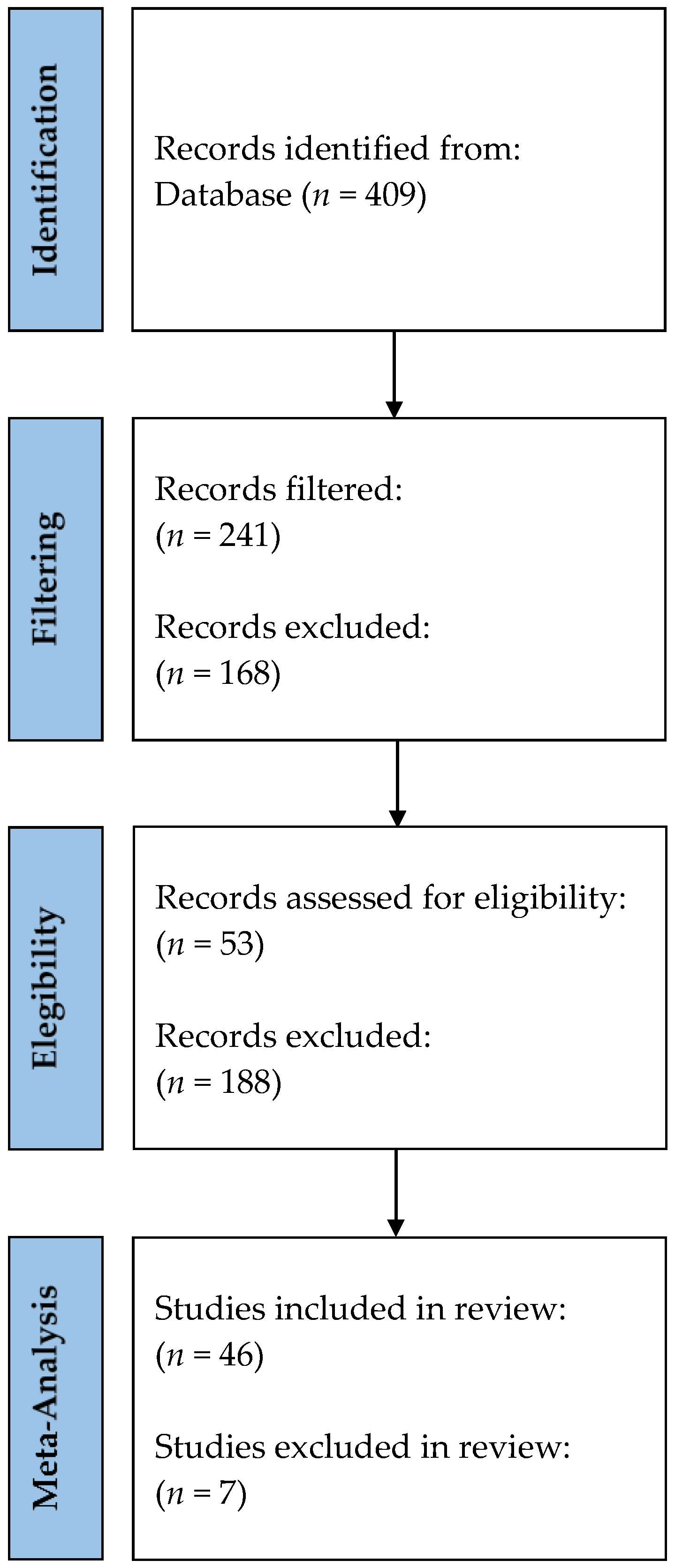
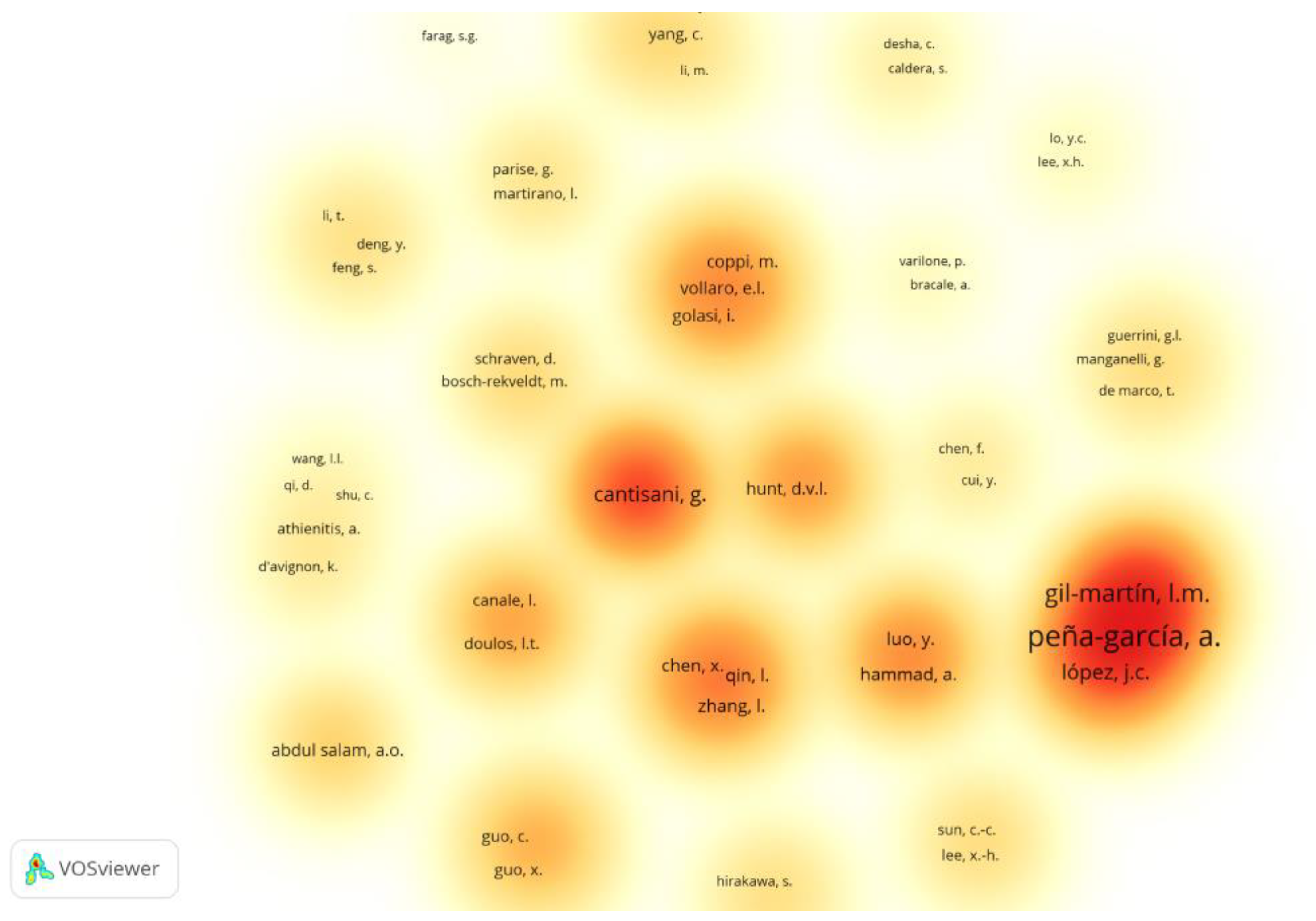
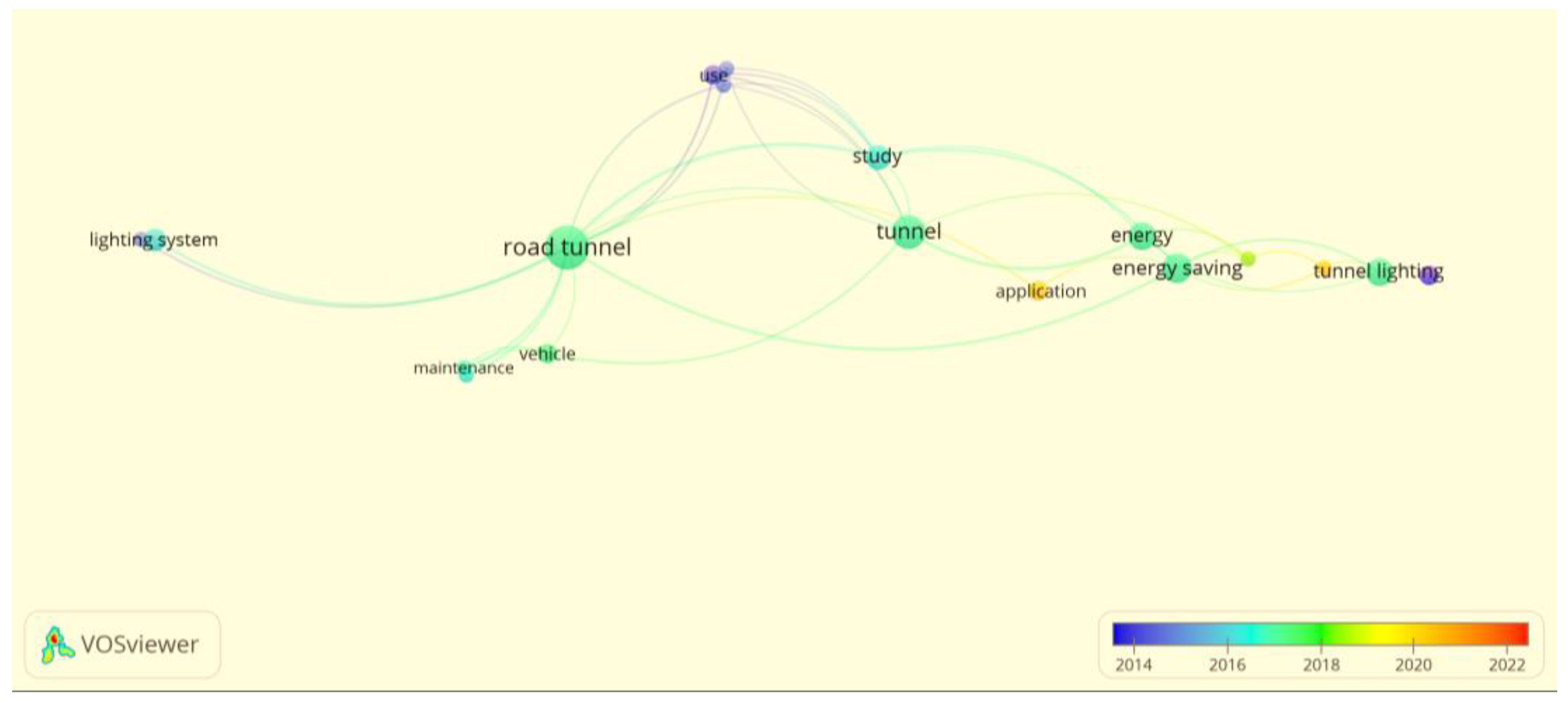
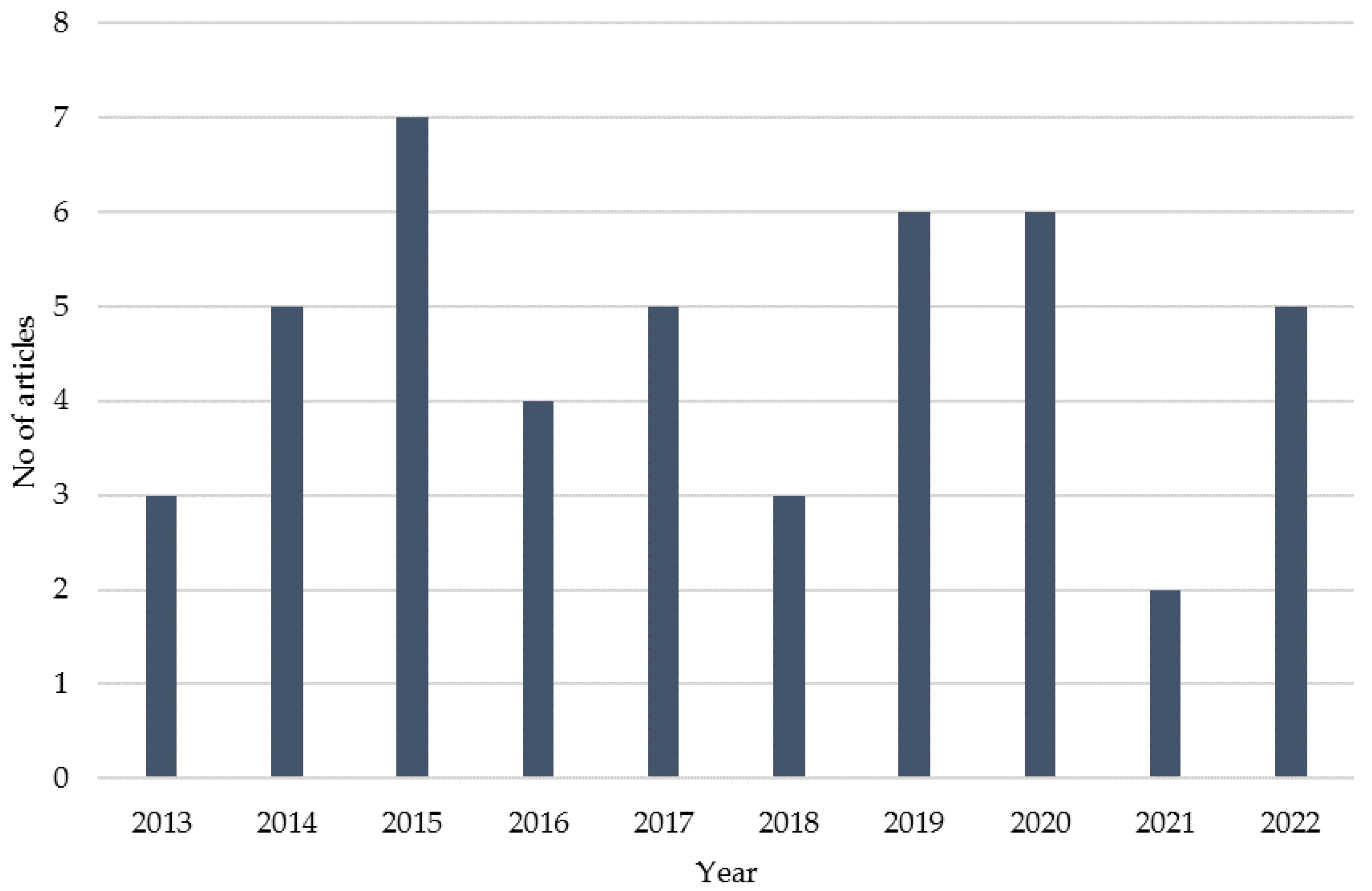
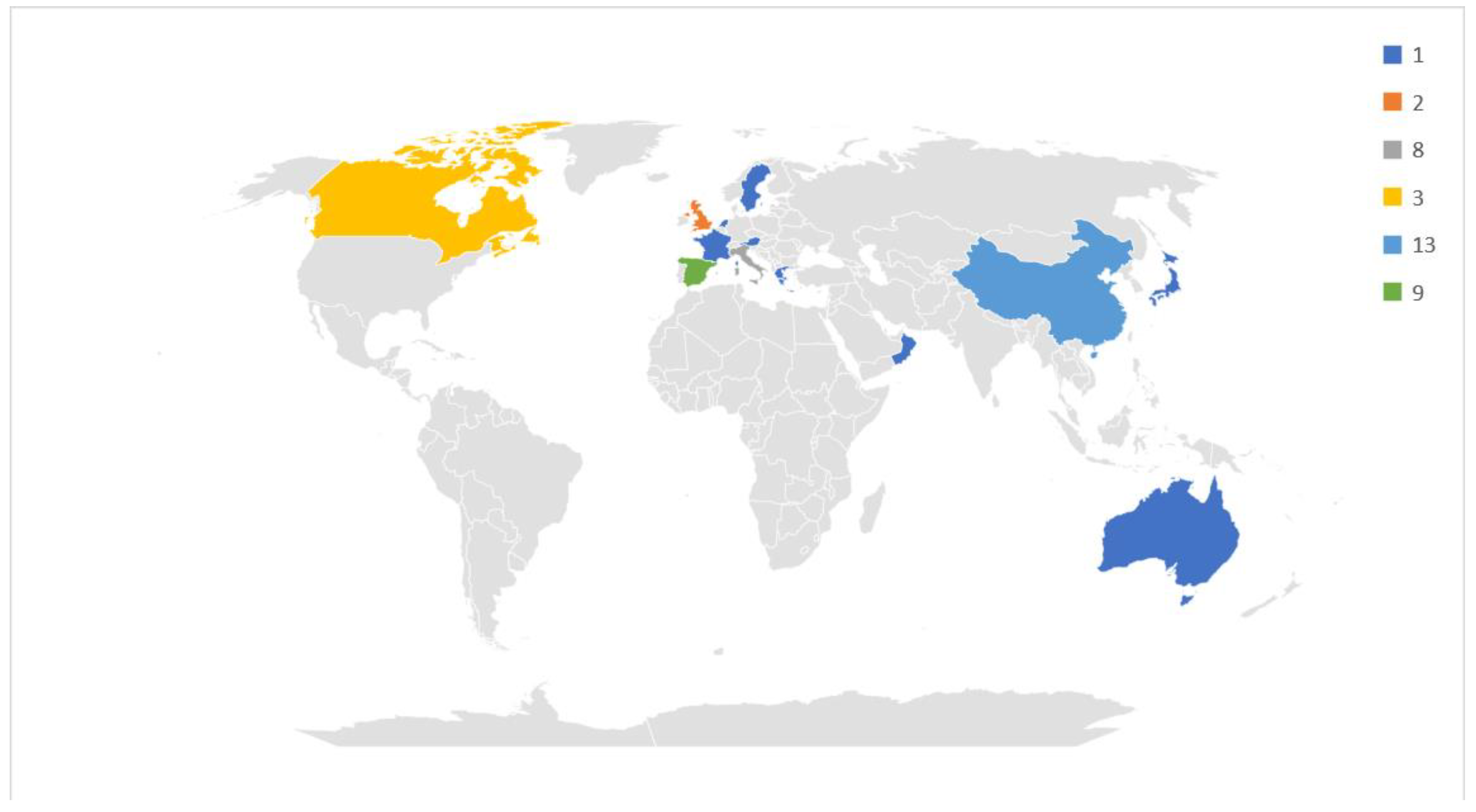

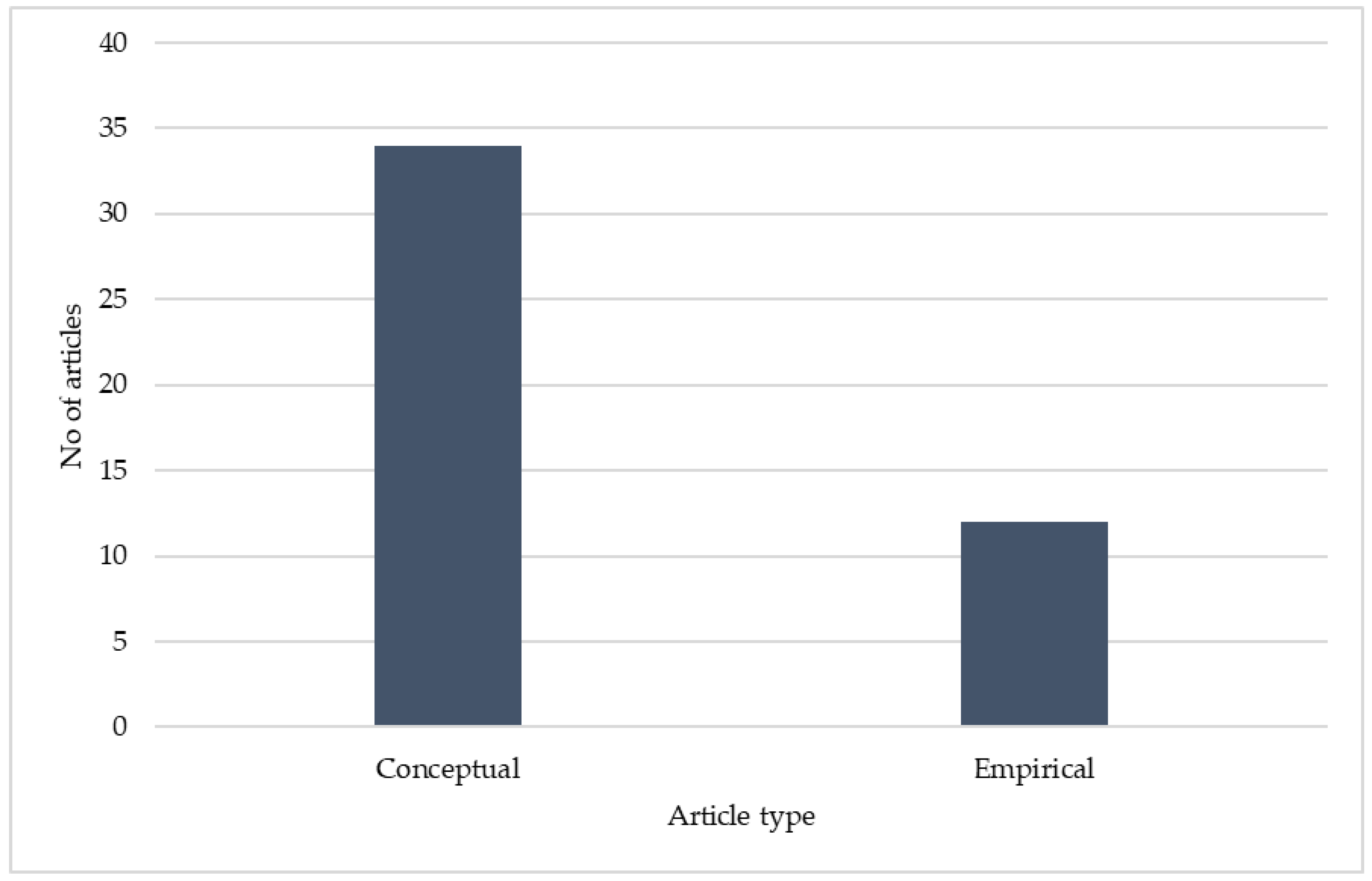

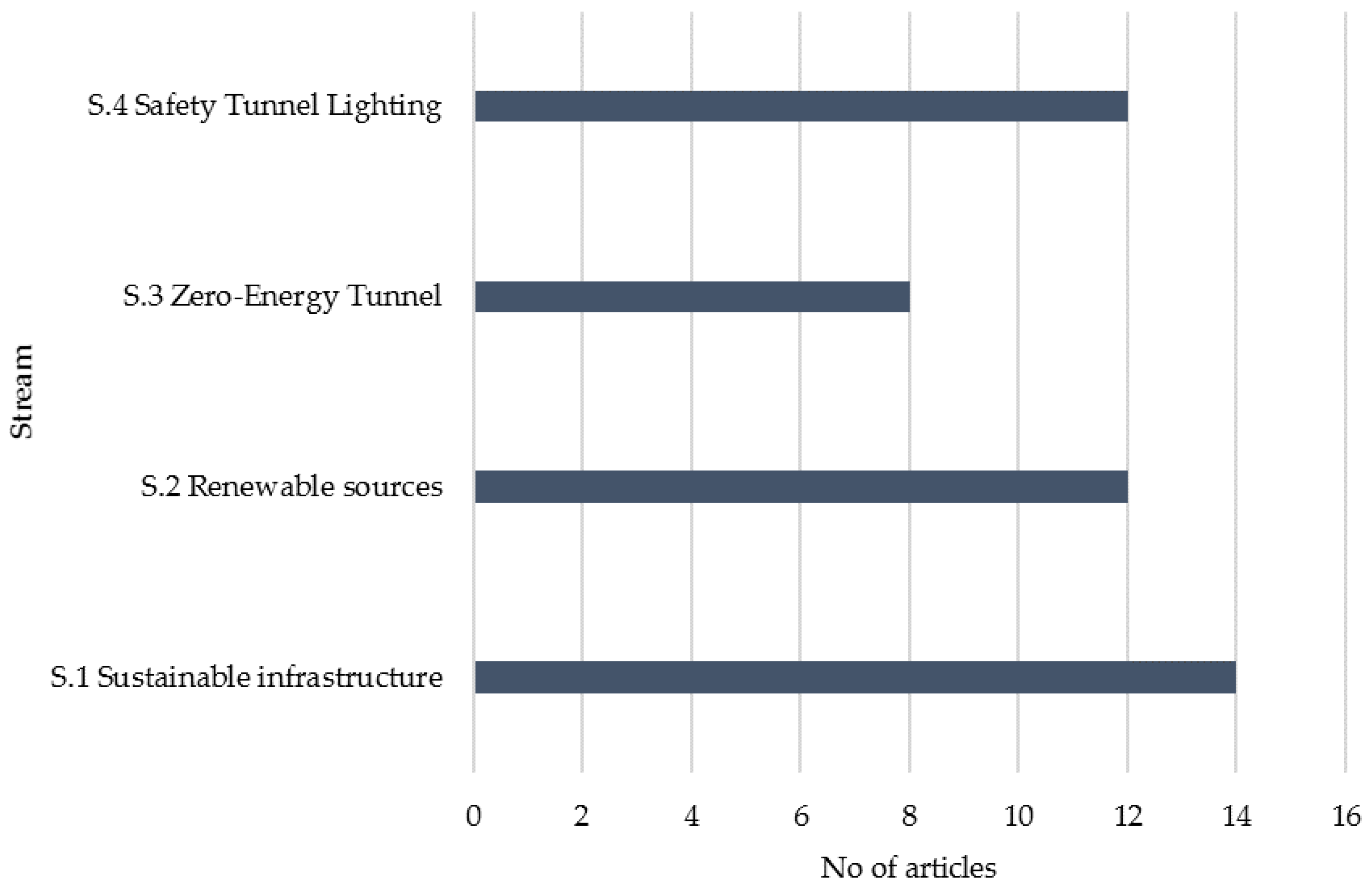
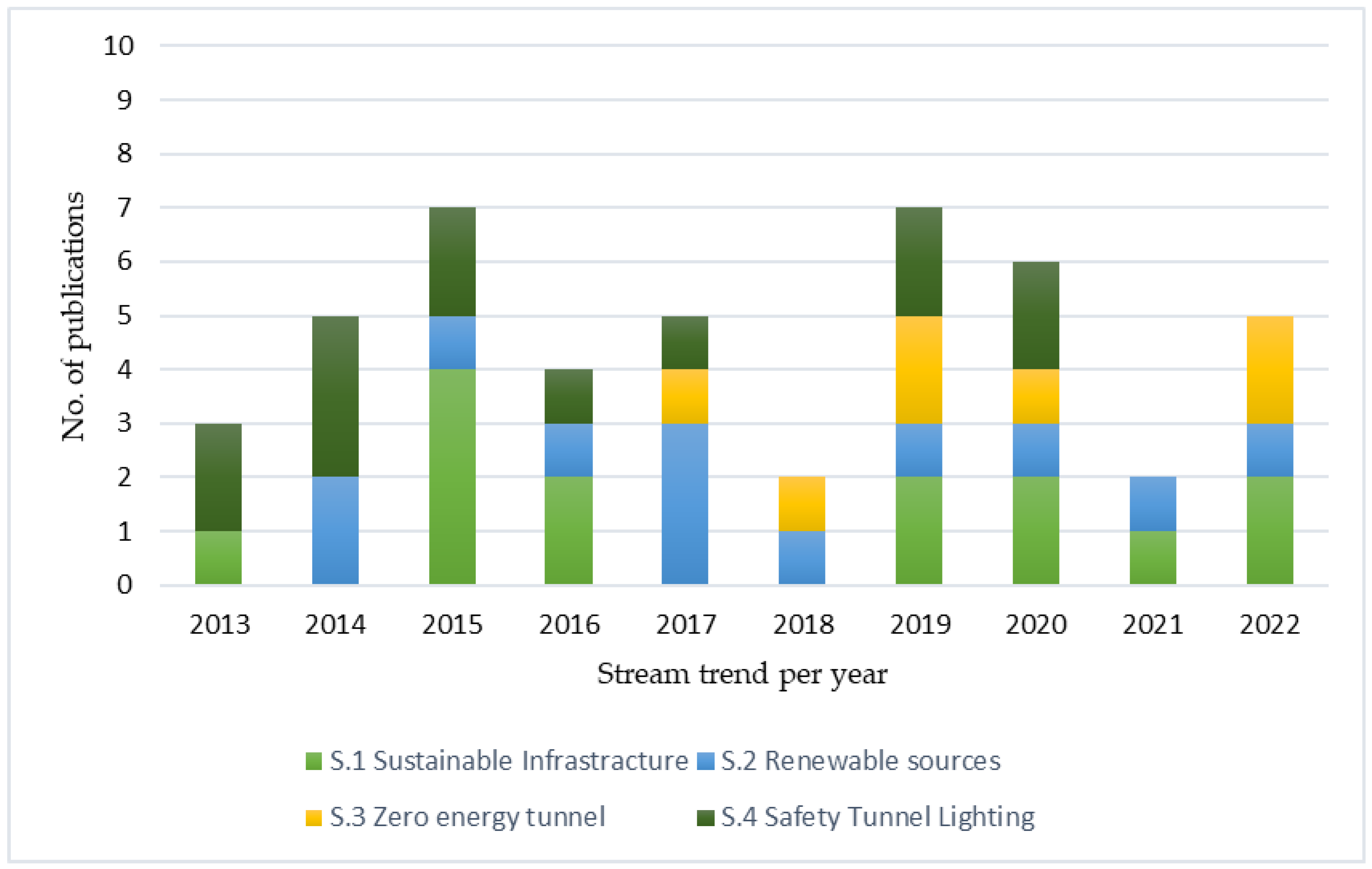
| STREAM | QUERY |
|---|---|
| QUERY A | TITLE-ABS-KEY (‘energy’ AND ‘saving’ AND ‘road’ AND ‘tunnel’) AND SUBJAREA (engineering AND energy) AND PUBYEAR > 2012 AND PUBYEAR < 2023 |
| QUERY B | TITLE-ABS-KEY (‘sustainable’ AND ‘infrastructure’ AND ‘tunnel’) AND SUBJAREA (engineering AND energy) AND PUBYEAR > 2012 AND PUBYEAR < 2023 |
| QUERY C | TITLE-ABS-KEY (‘energy’ AND ‘lighting’ AND ‘zero’ AND ‘tunnel’) AND SUBJAREA (engineering AND energy) AND PUBYEAR > 2012 AND PUBYEAR < 2023 |
| Inclusion Criteria | Description |
|---|---|
| Keywords | Safety tunnel lighting, renewables energy, road safety, zero energy tunnel, energy demand |
| Language | English |
| Source type | Peer-reviewed articles |
| Time interval | 2013–2022 |
| Subject Topic | Definition |
|---|---|
| S.1 Sustainable infrastructure | Limit the negative impact of climate change. |
| S.2 Renewable sources | The use of renewable sources: PV, wind, etc. |
| S.3 Zero-energy tunnel | Minimise to near zero the use of energy; improve efficiency. |
| S.4 Tunnel safety lighting | Reduce the amount of energy consumed to ensure safety of the tunnel lighting system. |
| Journal | H-Index | Quartile Citation |
|---|---|---|
| Advances in Civil Engineering | 33 | Q2 |
| Applied Optics | 203 | Q2 |
| Applied Mechanics and Materials | 37 | - |
| Applied Sciences (Switzerland) | 75 | Q2 |
| Bautechnik | 19 | Q3 |
| Building and Environment | 172 | Q1 |
| Building Simulation | 38 | Q1 |
| Elektrische Bahnen | 12 | Q4 |
| Energies | 111 | Q1 |
| Frontiers in Sustainable Cities | - | - |
| IEEE Transactions on Industry Applications | 206 | Q1 |
| IOP Conference Series: Materials Science and Engineering | 48 | - |
| Journal of Donghua University (English edition) | 11 | Q4 |
| Journal of Light and Visual Environment | 19 | - |
| Modern Tunnelling Technology | 15 | Q3 |
| Progress in Photovoltaics: Research and Applications | 137 | Q1 |
| SAE Technical Papers | 116 | Q3 |
| Sustainable Cities and Society | 82 | Q1 |
| Sustainable Construction Materials and Technologies | 15 | - |
| Sustainability (Switzerland) | 109 | Q1 |
| Tunnelling and Underground Space Technology | 113 | Q1 |
| Tunnels and Tunnelling International | 15 | Q4 |
| Country | No. |
|---|---|
| China | 13 |
| Spain | 9 |
| Italy | 8 |
| Canada | 3 |
| United Kingdom | 2 |
| France, the Netherlands, Oman, Germany, Australia, Bulgaria, Greece, Switzerland, Japan | 1 |
| Ranking | Title | Author | Journal | Country | No |
|---|---|---|---|---|---|
| 1 | Management of road tunnels: Construction, maintenance and lighting costs | Moretti, L., Cantisani, G. & Di Mascio, P. | Tunnelling and Underground Space Technology | Italy | 77 |
| 2 | Energy optimization of road tunnel lighting systems | Salata, F., Golasi, I., Bovenzi, S., Vollaro, E., Pagliaro, F., Cellucci, L., Coppi, M., Gugliermetti, F. & Vollaro, A. | Sustainability | Italy | 59 |
| 3 | Study of light-pipes for the use of sunlight in road tunnels: From a scale model to real tunnels | Gil-Martín, L.M., Peña-García, A., Jiménez, A. & Hernández-Montes, E. | Tunnelling and Underground Space Technology | Spain | 54 |
| 4 | Decrease of energy demands of lighting installations in road tunnels based in the forestation of portal surroundings with climbing plants | Peña-García, A., López, J.C. & Grindlay, A.L. | Tunnelling and Underground Space Technology | Spain | 41 |
| 5 | Study of pergolas for energy savings in road tunnels: Comparison with tension structures | Peña-García, A. & Gil-Martín, L.M. | Tunnelling and Underground Space Technology | Spain | 40 |
| 6 | Use of sunlight in road tunnels: An approach to the improvement of light-pipes’ efficacy through heliostats | Peña-García, A., Gil-Martín, L.M. & Hernández-Montes, E. | Tunnelling and Underground Space Technology | Spain | 39 |
| 7 | History and recent development of multi-purpose utility tunnels | Luo Y., Alaghbandrad A., Genger T.K. & Hammad A. | Tunnelling and Underground Space Technology | Canada | 34 |
| 8 | Assessment of the future resilience of sustainable urban sub-surface environments | Makana, L.O., Jefferson, I., Hunt, D.V.L. & Rogers, C.D.F. | Tunnelling and Underground Space Technology | UK | 27 |
| 9 | Management optimization of the luminous flux regulation of a lighting system in road tunnels | Salata, F., Golasi, I., Poliziani, A., Futia, A., De Lieto Vollaro, E., Coppi, M. & De Lieto Vollaro, A. | Sustainability | Italy | 24 |
| 10 | Energy saving in tunnels lighting using shading structures | Salam, A.A. & Mezher, K. | IEEE | UK | 22 |
| Paragraph | Subject Topic | Summary |
|---|---|---|
| 4.1 | S.1 Sustainable infrastructure | Environmental, economic and social aspects must be evaluated simultaneously to make a tunnel system sustainable. Several studies presented herein summarise the different aspects described above; namely, to be resilient, tunnels must be built with sustainable materials, be equipped with smart systems that monitor their infrastructure, guarantee that safety requirements meet regulations and be designed with an economic evaluation of the road tunnel system’s lifetime in mind. |
| 4.2 | S.2 Renewable sources | The studies in this section address the issue of renewable resources for tunnels. Most of these studies present solutions that involve the use of PV systems; others propose the use of vegetation to reduce the energy required by portals. Most of the energy required is for the lighting system of the tunnel. Therefore, studies are cited that suggest ways to optimise and improve upon the design of already existing resources. |
| 4.3 | S.3 Zero-energy tunnel | The ‘zero-energy tunnel’ is a hot topic. Major proposals involve technological resources, such as the SCADA system; a point-by-point algorithm; the use of a self-developed software to evaluate the influence of the installation mode and angles of luminaires in the road tunnel; an investigation of reasonable time factors for CO-based emissions; and the use of a sliding plate based on transverse deceleration energy. |
| 4.4 | S.4 Tunnel safety lighting | In the context of green solutions, the topic of energy optimisation in lighting systems is most critical. Proposed solutions include exploiting LED lamps for performance uniformity; the use of tension structures through an equation that exploits the structural characteristics of a tunnel to reduce energy consumption; a management model that calculates luminous flux through a predictive control system; and an intelligent control system of road tunnel lighting that realises the effects of illumination as it moves with a vehicle. |
Disclaimer/Publisher’s Note: The statements, opinions and data contained in all publications are solely those of the individual author(s) and contributor(s) and not of MDPI and/or the editor(s). MDPI and/or the editor(s) disclaim responsibility for any injury to people or property resulting from any ideas, methods, instructions or products referred to in the content. |
© 2023 by the authors. Licensee MDPI, Basel, Switzerland. This article is an open access article distributed under the terms and conditions of the Creative Commons Attribution (CC BY) license (https://creativecommons.org/licenses/by/4.0/).
Share and Cite
Lombardi, M.; Berardi, D.; Galuppi, M.; Barbieri, M. Green Tunnel Solutions: An Overview of Sustainability Trends in the Last Decade (2013–2022). Buildings 2023, 13, 392. https://doi.org/10.3390/buildings13020392
Lombardi M, Berardi D, Galuppi M, Barbieri M. Green Tunnel Solutions: An Overview of Sustainability Trends in the Last Decade (2013–2022). Buildings. 2023; 13(2):392. https://doi.org/10.3390/buildings13020392
Chicago/Turabian StyleLombardi, Mara, Davide Berardi, Marta Galuppi, and Maurizio Barbieri. 2023. "Green Tunnel Solutions: An Overview of Sustainability Trends in the Last Decade (2013–2022)" Buildings 13, no. 2: 392. https://doi.org/10.3390/buildings13020392
APA StyleLombardi, M., Berardi, D., Galuppi, M., & Barbieri, M. (2023). Green Tunnel Solutions: An Overview of Sustainability Trends in the Last Decade (2013–2022). Buildings, 13(2), 392. https://doi.org/10.3390/buildings13020392













